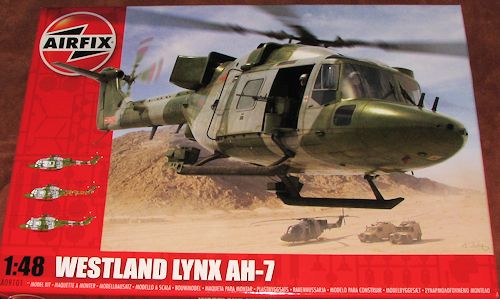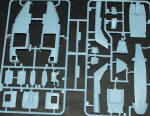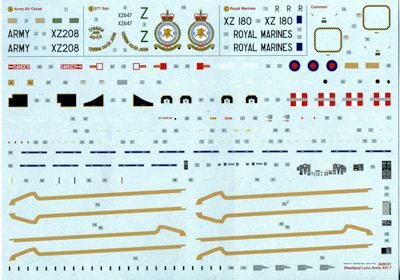
Airfix 1/48 Lynx AH.7
| KIT #: | A09101 |
| PRICE: | $20.99 on sale ($42.99 SRP) |
| DECALS: | Three options |
| REVIEWER: | Scott Van Aken |
| NOTES: |

| HISTORY |
The Westland Lynx is a British multi-purpose military helicopter designed and built by Westland Helicopters at its factory in Yeovil. Originally intended as a utility craft for both civil and naval usage, military interest led to the development of both battlefield and naval variants. The Lynx went into operational usage in 1977 and was later adopted by the armed forces of over a dozen nations, primarily serving in the battlefield utility, anti-armour, search and rescue and anti-submarine warfare roles.
The Lynx was the world's first fully aerobatic helicopter. In 1986 a specially modified Lynx set the current Fédération Aéronautique Internationale's official airspeed record for helicopters. The Westland 30 was derived from the Lynx as a civil utility helicopter, however it was not a commercial success and only a limited number were built. In the 21st century, a modernised military variant of the Lynx, designated as the AgustaWestland AW159 Wildcat, as multirole combat helicopter scheduled to enter service in 2014. The Lynx remains in production under AgustaWestland, the successor to Westland Helicopters.
The AH.7 is a further upgraded version of the AH.5 for the Army Air Corps, with Gem 41-1 engines and uprated gearbox of AH.5 and new, larger, composite tail rotor. Later refitted with BERP type rotor blades. Twelve new build, with 107 Lynx AH.1s converted. A small number also used by the Fleet Air Arm in support of the Royal Marines. Now replaced by the WAH-64 Apache as the main attack helicopter.
| THE KIT |
 I
have always liked the Lynx. It is just a neat looking helo and while all the
later add-ons have made the HAS.8 a rather fugly looking aircraft, the basic
aircraft is still hidden under all that 'stuff'. For that reason, I have
eschewed the latest naval version and when it went on sale, I picked up the Army
variant.
I
have always liked the Lynx. It is just a neat looking helo and while all the
later add-ons have made the HAS.8 a rather fugly looking aircraft, the basic
aircraft is still hidden under all that 'stuff'. For that reason, I have
eschewed the latest naval version and when it went on sale, I picked up the Army
variant.
Though it cannot be more than a couple of years old, Airfix no longer likes to put a date on their boxes. We do know that it was made in India and contains over 230 pieces, more than enough for just about any helo fan. There are parts for three different AH.7s in the box and one really needs to decide which version one is going to build right from the start as even the seats are different and one will need to drill holes for other pieces in the first construction step. As a note, since Airfix does not provide a parts layout diagram, I have only included a representative image of the sprues. I am sure you can find others on the net.
As you would expect, the cockpit is well detailed with collective, cyclic and pedals included. A harness is molded on the seats, which is a nice touch. There are decals provided for the instrument panels and consoles. The cabin has the option of how the seats are aligned and the cabin doors are separate pieces that can be posed open, closed or left off. Front doors are separate and while shown built in the closed position could probably be done open as well.
Due to the differences in parts used on the engine covers and
exhaust between the variants, entire sections of the instructions have different
build sequences depending on your version. The most complex is the box art plane
with the exhaust diffusers and the door guns. Different noses are also supplied
one with a bunch of sensors on it and the other smooth. There are also
differences in antenna suites between
 the
variants and one version carries TOW missiles. Same goes for the cockpit roof
with the TOW version having a sight tower installed there.
the
variants and one version carries TOW missiles. Same goes for the cockpit roof
with the TOW version having a sight tower installed there.
Another neat option is that one can build the kit with the rotor blades extended or folded. In the folded position one uses rotor braces that are included. All versions have the final blade type installed.
Instructions are well done wiht the usual Humbrol only paint numbers provided. It is only when one gets to the very large camo and markings fold out that actual color names appear. All are in a wrap scheme of Dark Green and Grey. One is the box art plane from Afghanistan in 2006, Another is a Royal Marine bird with 847 NAS in 2005 and the final option is a special scheme with a yellow and black tiger tail from 671 Squadron in 2005. The decal sheet is printed by Cartograf and includes a rather extensive data markings suite that includes the buff yellow blade leading edges.
| CONCLUSIONS |
| REFERENCES |
http://en.wikipedia.org/wiki/Lynx_AH7
September 2013
Thanks to me for scarfing up the preview kit.
If you would like your product reviewed fairly and fairly quickly, please contact the editor or see other details in the Note to Contributors.